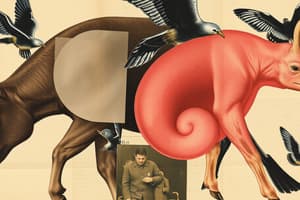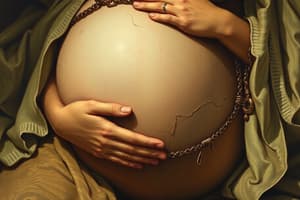Podcast
Questions and Answers
What are the three stages of the birthing process?
What are the three stages of the birthing process?
First stage of labour, Second stage of labour, Third stage of labour
What typically happens during the first stage of labour?
What typically happens during the first stage of labour?
The amniotic sac ruptures, uterine contractions occur, and the cervix dilates.
What occurs in the second stage of labour?
What occurs in the second stage of labour?
The baby is pushed out through the birthing canal.
What is expelled during the third stage of labour?
What is expelled during the third stage of labour?
What is Anoxia?
What is Anoxia?
What defines premature birth?
What defines premature birth?
Which of the following is a pattern of growth in infancy?
Which of the following is a pattern of growth in infancy?
The second stage of labour lasts approximately 30 to 80 minutes.
The second stage of labour lasts approximately 30 to 80 minutes.
Low birth weight only applies to babies born before the 38th week of gestation.
Low birth weight only applies to babies born before the 38th week of gestation.
What are the four main areas of development in infants?
What are the four main areas of development in infants?
How does myelination impact brain development in infants?
How does myelination impact brain development in infants?
What is the average amount of sleep for a newborn, and how does it change by four weeks?
What is the average amount of sleep for a newborn, and how does it change by four weeks?
What are the potential benefits and risks associated with shared sleeping for infants?
What are the potential benefits and risks associated with shared sleeping for infants?
Which state of infant sleep/wakefulness is considered optimal for learning and interacting with others?
Which state of infant sleep/wakefulness is considered optimal for learning and interacting with others?
What does the cephalocaudal principle refer to in motor development?
What does the cephalocaudal principle refer to in motor development?
What role does experience play in the onset of motor skills in infants?
What role does experience play in the onset of motor skills in infants?
What are the two types of grip mentioned for fine motor skills?
What are the two types of grip mentioned for fine motor skills?
At what age do infants typically learn to walk?
At what age do infants typically learn to walk?
How do rhythmic patterns relate to motor behavior in infants?
How do rhythmic patterns relate to motor behavior in infants?
Flashcards
First Stage of Labor
First Stage of Labor
The first stage of labor involves uterine contractions that cause the cervix to thin (effacement) and open (dilation), pushing the baby down into the birth canal.
Second Stage of Labor (Delivery)
Second Stage of Labor (Delivery)
This stage starts when the baby's head and body move through the birth canal and ends with the baby's birth.
Third Stage of Labor (Afterbirth)
Third Stage of Labor (Afterbirth)
This stage involves the placenta, umbilical cord, and membranes detaching and being expelled.
Anoxia
Anoxia
Signup and view all the flashcards
Premature Birth
Premature Birth
Signup and view all the flashcards
Preterm Babies
Preterm Babies
Signup and view all the flashcards
Small for Date Babies
Small for Date Babies
Signup and view all the flashcards
Cephalocaudal Pattern
Cephalocaudal Pattern
Signup and view all the flashcards
Myelination
Myelination
Signup and view all the flashcards
Blooming and Pruning
Blooming and Pruning
Signup and view all the flashcards
Vision Development
Vision Development
Signup and view all the flashcards
Perceptual Constancy
Perceptual Constancy
Signup and view all the flashcards
Size Constancy
Size Constancy
Signup and view all the flashcards
Emotional Regulation
Emotional Regulation
Signup and view all the flashcards
Stranger Anxiety
Stranger Anxiety
Signup and view all the flashcards
Fine Motor Skills
Fine Motor Skills
Signup and view all the flashcards
Palmer Grasp
Palmer Grasp
Signup and view all the flashcards
Pincer Grasp
Pincer Grasp
Signup and view all the flashcards
Fear
Fear
Signup and view all the flashcards
Study Notes
Birthing Process
- The birth process involves three stages: the first stage of labour, the second stage of labour (delivery), and the third stage of labour (afterbirth).
- The first stage of labour is the longest stage, lasting an average of 6 to 12 hours, but can vary depending on factors like the mother's age and prior pregnancies.
- The first stage of labour begins with uterine contractions and the rupture of the amniotic sac (water breaking).
- Uterine contractions cause effacement (thinning) and dilation (opening) of the cervix, pushing the baby downward into the birth canal (vagina).
- The second stage of labour involves pushing the baby out and starts when the fetus' head and body begin moving through the birth canal.
- This stage lasts approximately 30 to 80 minutes.
- The third stage occurs when the placenta, umbilical cord, and other membranes are detached and expelled (afterbirth). This is the shortest stage, typically lasting only minutes.
Potential Problems at Birth
- Anoxia is a lack of oxygen to the brain which can lead to neurological damage or death.
- Premature birth refers to babies born before the 38th week of gestation and weighing less than 5.5 pounds.
- Low birth weight babies are categorized into two types: Preterm and Small for Date.
- Preterm babies are born more than 3 weeks before their due date.
- Small for date babies are underweight even if close to their due date, having experienced low growth as fetuses.
Physical Growth and Development in Infancy
- Cephalocaudal pattern: Early growth occurs at the top (head) with physical growth gradually progressing downward.
Brain Development
- Continued myelination and increased connectivity between neurons occur
- Brain regions experience blooming and pruning
- The visual cortex exhibits peak synaptic overproduction followed by gradual retraction
- Heredity and environment influence the timing and progression of brain development
- Myelination rates vary
Physical Growth and Development in Infancy
- Newborn infants typically sleep 16-18 hours per day
- Sleep duration reduces to 14 hours per day by 4 weeks
- Night waking is the most common infant sleep-related issue
- Excessive parental involvement in sleep-related interactions is linked to night waking
- Shared sleeping practices vary across cultures
- The American Academy of Pediatrics discourages shared sleeping
- Potential benefits of shared sleeping include promoting breastfeeding and quicker response to crying
- Bed-sharing increases the risk of sleep-related deaths, including sudden infant death syndrome.
Sleep/Wake States
- Regular sleep: closed eyes and regular respiration
- Irregular sleep: closed eyes, REM sleep, limb movement, and facial grimaces
- Drowsiness: infant is falling asleep or waking up, characterized by inactivity
- Alert inactivity: infant's eyes are bright and follow moving objects
- Waking activity: infant engages in diffuse motor activity, may become fussy
- Distress: intense crying and motor activity
Motor Development
- Infants develop motor skills through perceiving and acting
- Motor skills represent solutions to goals
- Motor development is an active process involving nature and nurture
- Development follows the cephalocaudal principle
- Motor behaviour is displayed in rhythmic patterns
Gross Motor Skills
- Involve large muscle activities
- Posture is a dynamic process linked to sensory information
- Learning to walk typically occurs around the first birthday
- Infants learn about safe surfaces and places for locomotion
- Milestones vary by as much as 2-4 months
- Experience can influence the onset of motor accomplishments
- Some infants don't follow the standard motor development sequence
- By 13-18 months, toddlers can pull toys and climb stairs
- By 18-24 months, toddlers can walk quickly, balance, walk backward, stand, and kick a ball
- Restricted motor activity doesn't impact reaching motor milestones at a normal age
Fine Motor Skills
- Involve finely tuned movements such as using spoons, buttoning shirts, reaching, and grasping
- The Palmer grasp involves grasping with the whole hand
- The pincer grip involves grasping with the thumb and forefinger
Sensory and Perceptual Development
- Vision: Newborn's vision is 20/240, improving to 20/40 by 6 months
- Infants show interest in human faces soon after birth
- Infants spend more time looking at their mother's face than a stranger's face
- A 2-month-old scans more of the face than a 1-month-old
- Colour vision develops at 4-8 weeks, with colour preference at 4 months
- Perceptual constancy: sensory stimulation changes, but physical world perception remains constant
- Size constancy: recognition that an object remains the same despite changes in retinal image
- Shape constancy: recognition that an object remains the same shape despite orientation changes
- Depth perception is studied using the "visual cliff"
- Infants between 6-12 months can distinguish depth
Language Milestones in Infancy
- Biological influences: Evolution of nervous system, vocal apparatus, and language-specific brain regions like Broca's area (language production) and Wernicke's area (language comprehension).
- Language Acquisition Device (LAD) theory: Children are biologically endowed to detect language features and rules.
Emotional and Personality Development
- Emotion: Feeling or affect triggered by significant events
- Biological influences: Certain brain regions, like the limbic system and amygdala, are involved in emotions.
- Environmental influences: Relationships and culture shape emotional experiences.
- Primary emotions: present in humans and animals
- Self-conscious emotions: require self-awareness and a sense of "me"
- Fear: One of the earliest emotions in babies
- Stranger anxiety: Showed by infants as fear and wariness toward strangers, appearing around 6 months and intensifying at 9 months
- Emotional regulation and coping are influenced by caregivers, who reduce stress hormones through soothing and swaddling
- Infants gradually learn to minimize emotional reactions
- Spoiling is not possible within the first year of life
Studying That Suits You
Use AI to generate personalized quizzes and flashcards to suit your learning preferences.




